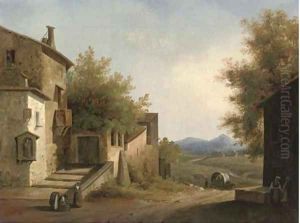Sir Augustus Wall Calcott Paintings
Sir Augustus Wall Callcott was an influential British landscape painter, born in Kensington, London on February 20, 1779. He was a contemporary of artists such as J.M.W. Turner and John Constable and was part of the Romantic movement in art, which emphasized emotion and individualism as well as glorification of the past and nature. Callcott initially started his career as a choirboy at the Chapel Royal, St James's Palace, but his passion for art led him to pursue painting instead.
Callcott began his artistic training under the landscape artist John Hoppner and also studied at the Royal Academy Schools in London. His early work was influenced by Dutch landscape painting of the 17th century, but he gradually developed his own style. He became known for his serene landscapes and coastal scenes, which often incorporated historical or classical themes. His compositions were praised for their clarity, subtle use of light, and calm, reflective atmosphere.
In 1806, Callcott was elected as an Associate of the Royal Academy and became a full Academician in 1810. His reputation grew, and he became one of the most respected landscape painters in England. In addition to his landscape works, Callcott also painted marine scenes and historical subjects. He was also a talented musician and composer.
Throughout his career, Callcott traveled extensively in search of inspiration for his paintings. He visited various parts of the UK, including the Lake District, which was a popular subject for Romantic artists, as well as continental Europe, particularly Italy, where he studied the works of the Old Masters and was inspired by the Italian landscape.
In 1837, Callcott was knighted by Queen Victoria, a testament to the high regard in which he was held as an artist. He married the writer and artist Maria Dundas, the widow of Thomas Graham, who became Lady Callcott. She was a significant figure in her own right and supported her husband's career while also engaging in her literary and educational pursuits.
Sir Augustus Wall Callcott's work was characterized by its refinement, technical skill, and a sense of tranquillity, which made him a leading figure in British art during his lifetime. He influenced a generation of landscape painters and left behind a substantial body of work that continued to be appreciated after his death. He passed away on November 25, 1844, in Kensington, leaving behind a legacy as one of the foremost landscape painters of his time.
